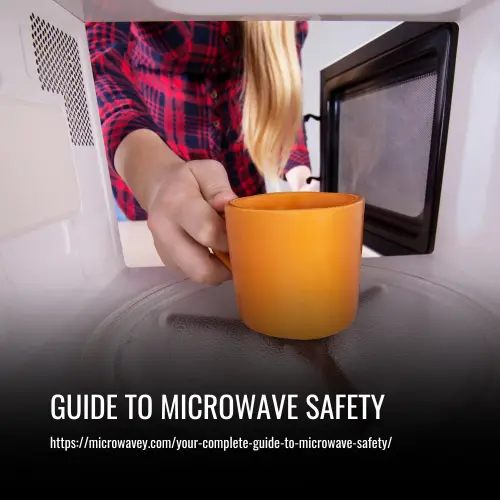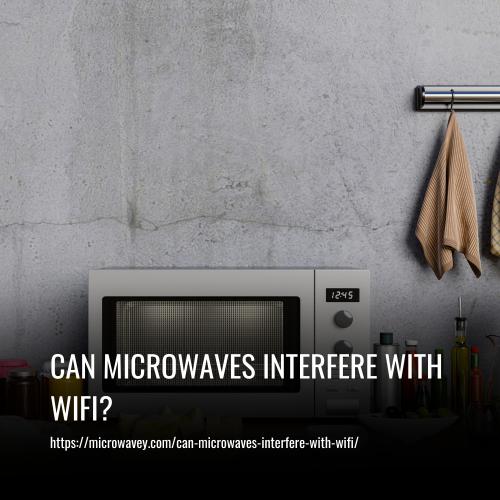Your Complete Guide to Microwave Safety
To use a microwave safely never turn it on with any metal items inside. Also, keep it clean and only microwave the materials for the listed times. Microwaving certain foods for too long can cause damage to the machine itself and create a mess. Finally, stop the microwave if the door ever opens.
So, these are some of the most basic safety tips, however, throughout the rest of the article, I will go over some of the most common safety questions that people have about microwaves and how you can keep your microwaves in good repair, while also keeping yourself and others safe.

Microwave Cooking And Nutrition
Microwave cooking has been shown to have minimal impact on the nutritive value of food compared to conventional cooking methods. Studies indicate that microwaving food can actually help retain water-soluble vitamins like vitamin C and thiamin, as it requires minimal water and cooking time. Additionally, microwave cooking can promote mineral retention in vegetables and does not significantly affect the macronutrients of proteins, fats, and carbohydrates.
While there may be some loss of soluble phenolic antioxidant compounds in vegetables cooked in a microwave, this could be due to excessive use of cooking water. The quality of protein in microwaved food is often better than conventionally cooked food, as there is less oxidation in meat cooked in a microwave.
Microwaving Food And Uneven Heating
Microwaving food can lead to uneven heating, which can result in portions of the food being undercooked and potentially allowing microorganisms to survive. To mitigate this issue, manufacturers suggest using stirrer fans, turntables, and standing times to ensure that the food is heated uniformly. It is important to ensure that frozen food is completely thawed before microwaving to prevent uneven cooking and the survival of dangerous microorganisms.
While there have been concerns about the potential effects of microwaving food, such as the formation of toxic compounds, experts have concluded that there is no substantial evidence to support these claims. Microwaves themselves do not remain in the food after cooking, and therefore do not pose a radiation risk. Proper cooking techniques and following manufacturer instructions can help ensure safe and even heating of food in a microwave oven.
Containers And Films For Microwave Cooking
When using containers and films for microwave cooking, it is important to follow safety guidelines. Only utensils designed for microwave use should be used, and plastic containers should be specifically designed for microwave cooking. It is recommended to not use plastic films in direct contact with food, as additives in plastics may migrate into food at high temperatures.
Containers designed for frozen or chilled foods should not be exposed to high temperatures in the microwave, as this can lead to migration of contaminants into the food. Glass containers are preferred for heating fatty foods, as they are less likely to cause migration. Circular or oval containers are better for even heating, while shallow containers provide a large surface area for heating.
Packaging for microwavable meals may include susceptors, which help enhance browning and crisping of food. Susceptors are made of plastic film metallised with aluminum, and are safe for use in microwave cooking. The packaging industry continuously monitors and improves manufacturing processes to ensure the safety of microwave cooking containers and films.
Radiation And Leakage
It is important to ensure that your microwave oven is functioning properly to prevent any radiation leakage. Microwave doors should always be properly sealed and free from damage to prevent any leaks. It is recommended to have your oven inspected by a qualified technician if you notice any issues with the door.
Microwave ovens are tested for leakage before sale to ensure they meet safety standards. It is rare for microwave ovens to exceed the recommended leakage levels if they are in good condition and used correctly. If you have any concerns about radiation leakage, you can have your oven tested by a professional.
It is also recommended to use a microwave leakage detector that complies with safety standards to ensure accurate results. Following the manufacturer’s instructions carefully will help you determine if there is any leakage from your microwave oven.
For more information on microwave radiation and safety precautions, you can visit the Australian Radiation Protection and Nuclear Safety Agency (ARPANSA) website. They provide valuable information on non-ionizing radiation, including tips on how to safely use microwave ovens.
Is it Safe to Use a Microwave Without Light?
If you start using your microwave and find that the light that is typically active while cooking is no longer working, you don’t have to worry. This simply means that the lightbulb for the microwave has burnt out and you just need to buy another one. It will be best to try and replace the lightbulb as quickly as possible as this just helps you tell if you are overcooking any of your food, however, you can still use the microwave even when the lightbulb is dead.
Most microwave providers recommend that when you are replacing a bulb on a microwave you do it through an authorized service agent.
When replacing the lightbulb of the microwave you will want to unplug the microwave in order to avoid the unlikely chance that you receive a serious shock, and then you will want to look at the user’s manual which will show how to replace the lightbulb. Another easy option is to find a Youtube video demonstrating how to replace the bulb, though you will want to make sure the video is the exact same type of microwave as yours.
Is it Safe to Use During a Thunderstorm?
The most straightforward answer to this is no, you should not cook anything in the microwave when there is a thunderstorm going on. There are three main reasons why you shouldn’t use your microwave when there is a thunderstorm going on.
First, when you are cooking and using a microwave during a thunderstorm, you are at a serious risk of there being a surge which can cause the food that you are cooking to catch fire or explode. I shouldn’t have to explain why this is bad, but there is also the added effect that these power surges can cause a variety of different effects on containers that may be in the microwave as well.
Second, while you are at risk of the surge burning or causing your food to explode, you are also at risk of large shocks that can hit anyone standing too close to the microwave when this happens. These parts can cause electrical burns which are extremely painful and dangerous to anyone who is close to the microwave.
Third, and probably the least important compared to the other danger risks, is that having your microwave running during a thunderstorm will likely cause significant damage to the microwave itself. The previously mentioned possible surge, even if it doesn’t cause your food to start burning or explode will be very likely to cause damage to the microwave, and you might have to replace it depending on how badly damaged it is.
Can You Use a Microwave With Rust Inside?

This is another safety problem where there is no maybe. If you have any rust showing on your microwave you should not use the microwave in any way. There are two major reasons that using a microwave is dangerous and why you should either find a way to get rid of the rust or get a new microwave.
First, when you start using a microwave that has rust you are going to see that the amount of sparks and arching is going to increase dramatically. This is because the microwave rays are going to bounce off of the metal and spark. So, if you ever notice that your microwave starts sparking then you will want to immediately stop the microwave and check the microwave. If you see any rust then you will want to disconnect the microwave just to make sure that nobody uses it and accidentally starts a fire from the sparks.
Second, you are going to have to worry about microwave radiation leakage. I will cover some of the general safety tips about microwave radiation later, however, if your microwave has rust on the inside then there is a chance that it is leaking tradition while running. This is only a problem if there is rust on the door of the microwave, however, it is a major problem as the radiation from a microwave can cause problems such as glaucoma, and leukemia if absorbed into the cells.
Can You Use a Microwave Without a Turntable?
While the past few safety questions have all been negative, you, fortunately, can use your microwave even if you down have a turntable in it. However, if you do decide to use your microwave when you don’t have a turntable you are going to want to know that your food is going to cook unevenly.
This is because the turntable is there to rotate the food and make sure the microwave’s radiation hit the food evenly from every direction and heat everything the same. So, if you don’t have your turntable then you are going to want to microwave the food in a short burst and then turn the food and do another short burst so that every side is heated evenly.
However, when it comes to using the microwave without a turntable is not recommended as most microwave manufacturers should only be used it when there is a turntable fitted into the microwave having the food rotating. This is because there is the potential of the microwave getting damaged if there is no turntable, but the microwave can work safely without the turntable.
If you have damaged the turntable for whatever reason, you typically can get a replacement turntable fairly cheaply and without too much of a hassle. And if the problem is just that the turntable isn’t turning, then you will want to make sure that the microwave is clean, as typically it is just food stopping it from turning. If this isn’t the problem then check out the section of this article titled What to do if Your Microwave Has Safety Problems? to find out what you should do.
Can You Use a Microwave Without a Waveguide Cover?

You are going to want to avoid using your microwave if you don’t have a waveguide cover or if the cover is damaged. The waveguide cover is placed inside the microwave in order to transmit the radiation that the microwave produces into the area where you put your food while also protecting the electrical elements of the microwave from steam and bits of food.
So if the waveguide cover is damaged or missing then you are extremely likely to damage your microwave, either from the radiation not being properly directed or by steam and food getting into the electrical parts of the microwave. Typically the waveguide cover is located inside the microwave on one of the side walls, however, it can be located on top. To find out where your cover is, make sure it is completely intact and there, then check your user’s manual.
Your waveguide cover should easily be able to last as long as your microwave does, however, if you don’t handle your microwave with care and are placing and removing plates and bowls from the microwave violently then you can damage the waveguide without too much of a problem. Getting the cover can be a hassle as you need special equipment to get it secured and all set up so I would strongly recommend that you take good care of your microwave to avoid damaging the waveguide cover.
Can You Microwave Aluminum Foil or Other Metal?
Most people already know that you typically don’t want to put any sort of metal into your microwave unless the metal states that it is microwave safe or if your microwave owner’s manual states otherwise. The Food and Drug Administration states, that you should avoid any metal in the microwave as the microwaves will reflect off of the metal and can cause damage to either the microwave or cook your food unevenly.
However, you still are able to put some tin foils into microwaves and have it be completely safe for both your food and for the microwave. The Food Safety and Inspection Service of the United States Department of Agriculture tells us that you need to make sure that the food you are trying to cook isn’t completely covered by the foil, as this will prevent cooking and cause microwave damage.
This doesn’t mean you can’t use foil, as using small amounts of foil can be perfectly safe. If you are heating up pre-prepared food in the microwave that has aluminum foil, read the label to find out if it is safe to go into the microwave or not. However, it might be safer to simply put it into a microwave-safe container instead of leaving it in the container it came in.
Lastly, the USDA gives these quick tips for when you are microwaving aluminum foil:
- Only use new and smooth foil to prevent sparks.
- You shouldn’t cover more than 1/4 of the food in foil.
- It doesn’t matter what side of the foil is facing outwards.
- Shape the foil to the food so there aren’t any edges.
- Keep the foil at least one inch away from the microwave walls.
- Immediately remove the food and the foil from the microwave if you begin to see any sparks. Remove foil from food, then continue cooking.
Microwave Radiation Safety Tips

When it comes to the microwave and how safe it is, you don’t have to worry and the FDA has many different regulations in order to make the microwave extremely safe. When it comes down to it, the vast majority of injuries that come from microwaves are from explosions of boiling water or other liquids, with cause serious burns. So, when handling hot liquids, make sure to be careful as disturbing them can cause explosions, which are the most common injuries from microwaves.
However, if you do end up receiving any sort of radiation from the microwave, you can easily end up with some serious burns. The two areas of the body that are most vulnerable to radiation are the eyes and the testes. Typically the injuries from radiation are burns or cataracts. To help prevent this, always make sure that the door of the microwave classes and stays latched as this is the most common reason for any sort of radiation-related injuries.
What to do if Your Microwave has Safety Problems?
If you do encounter any sort of safety problems with your microwave that can cause significant damage to the microwave, to the food, or to yourself, then you are going to want to start off by stopping any use of the microwave and unplugging the microwave so that it can’t be used by anyone who is unaware of the problem.
You then will want to contact the manufacturer of the microwave as they are going to be the most knowledgeable and will be able to inform you what to do next or to send someone who will be able to repair it if at all possible. While working on repairs, if the manufacturer finds any safety problems that don’t meet the Federal standard then they are required to notify the FDA in order to prevent future incidents. In addition, manufacturers are required to report all accidental radiation occurrences to the FDA.
FAQs
Microwaves can heat food quickly and evenly, but they do not change the chemical composition of the food, so it is safe to consume microwaved food.
Microwaves are designed with safety features that prevent exposure to radiation, so it is safe to stand near a microwave while it is in use.
Microwave ovens are tested to ensure that they do not leak radiation. As long as the oven is not damaged or altered, it is safe to use.
When used according to the manufacturer’s instructions, microwaves are safe to use and do not cause any health problems.
It is safe to use microwave-safe plastic containers, but it is important to follow the guidelines for safe microwave use provided by the container manufacturer.
Microwaves are designed to prevent interference with electronic devices, so it is unlikely for them to cause any interference with pacemakers or other devices.
Conclusion
In conclusion, using your microwave safely is crucial for both your health and the longevity of your appliance. By following the tips and guidelines in our guide, you can ensure that you’re making the most of this convenient kitchen appliance without putting yourself at risk. So be sure to always use your microwave with caution and care, and enjoy the convenience it brings to your daily cooking routine!


